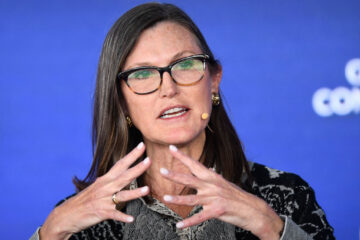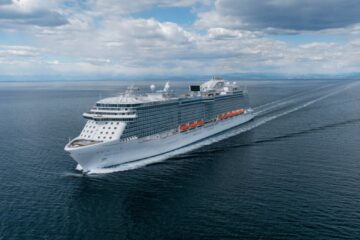Hey, this really is a Mickey Mouse outfit.
The iconic cartoon rodent is the living embodiment of the Disney (DIS) entertainment juggernaut, as well as its global ambassador.
Related: New Disney Cruise Line ship makes rescue on way to US debut
Created in 1928 by company Founder Walt Disney and animator Ub Iwerks, Mickey was a replacement for another character called Oswald the Lucky Rabbit.
The world famous mouse was going to be named Mortimer, until Disney’s wife, Lillian, suggested “Mickey” and here we are today.
The character has appeared in more than 130 films, comic strips, a TV show, videogames and a live character you can meet in Disney parks. And don’t forget all those watches.
💰💸 Don’t miss the move: SIGN UP for TheStreet’s FREE Daily newsletter 💰💸
The Mouse House recently beat Wall Street’s fiscal-fourth-quarter earnings expectations, and Bob Iger, the once and current CEO, gave analysts a rundown on the company’s condition since he returned to the top spot in 2022.
“We’ve emerged from a period of considerable challenges and disruption, and we’re well-positioned for growth,” Iger said during the company’s earnings call.
“We put in place specific strategies to generate growth across our businesses, and our solid results this quarter are a clear indication they’ve been successful.”
Iger, who came back after his appointed successor, Bob Chapek, was dismissed, said Disney began working extensively two years ago “to restore creativity to the center of the company.”
And the company worked through a proxy fight from the activist investor Nelson Peltz. In April Peltz’s Trian Fund Management lost a proxy fight when holders reelected the company’s board nominees. And in May, CNBC had reported, Trian sold its stake in Disney.
Disney CEO Bob Iger says the company has emerged from a period of challenges and disruption.
Disney CEO: Movie business has never been stronger
Disney’s branded series and general entertainment programming are performing exceptionally well, he said, “drawing new audiences and winning an unprecedented number of accolades, including a record-breaking 60 Emmy Awards.”
“In film, we’re extremely proud of our performance at the summer box office, fueled by the top two movies of the year to date: ‘Inside Out 2’ and ‘Deadpool & Wolverine,'” he said.
Related: Netflix hints at when subscriber rates may rise
Iger added that “a successful Disney movie today drives more value than it ever has.”
That point, he said, reflects the increased number of Disney’s “consumer touchpoints, extending the reach and impact of our world-class storytelling, from streaming to parks and resorts, cruise ships, consumer products, and games.”
“This multiplier effect means that the system economics of our movie business has never been stronger,” he said.
By the numbers, Disney earned an adjusted $1.14 a share, up from 82 cents in the year-earlier period and topping analysts’ consensus forecast of $1.10 a share.
Revenue totaled $22.57 billion, compared with $21.24 billion a year earlier and beating Wall Street’s call for $22.45 billion.
The company’s direct-to-consumer streaming business, which includes Disney+, Hulu and ESPN+, brought in $321 million in operating profit for the quarter, swinging from a loss of $387 million a year earlier. Streaming revenue increased 13% to about $6.3 billion.
“In five short years, we have built Disney+ into a streaming destination unlike any other, with more than 120 million core subscribers,” Iger said.
Disney’s stock is up 21% year-to-date and 22% from a year ago.
Veteran trader sees problems with Disney balance sheet
TheStreet Pro’s Stephen Guilfoyle acknowledged that Disney had a good quarter, but he had some reservations.
“Cash flows are strong,” said Guilfoyle, whose career goes back to the floor of the New York Stock Exchange in the 1980s. “The parks are strong. The studios are strong. Guidance is strong.”
He added, however, that Disney’s balance sheet “has long been a black eye for this firm.”
Disney ended the period with a cash position of a bit more than $6 billion and inventories of just over $2 billion, bringing current assets to $25.24 billion, Guilfoyle said.
Total liabilities add up to $34.6 billion, including shorter-term debt of almost $6.85 billion, but also deferred revenue of $6.68 billion which is not a true financial obligation.
“At the headline, these numbers put Disney’s current and quick ratios at 0.73 and 0.67, respectively,” he said. “That’s fairly awful to be honest.”
Once adjusted for the deferred revenue, the ratios improve to 0.9 and 0.83, but Guilfoyle said “these ratios still do not pass muster.”
More Retail Stocks:
Starbucks makes a major move many coffee drinkers will loveAmazon’s big tech plans pay off for customers (and its pockets)Once nearly-bankrupt used car dealer hits new highs
“I like Disney,” he said. “Honestly. I want to just invest in the firm. but we cannot act on emotion. This stock is tradable. The company? I would rather not invest in Disney until that balance sheet shows marked improvement.”
Investment firms review Disney
Investment firms issued research reports after Disney posted earnings, including Bank of America Securities, which maintained its buy rating and $120 price target.
B of A called Disney’s fourth-quarter results mixed, with revenue above its estimates while operating profit was modestly below the investment firm’s expectations.
Disney has a collection of best-in-class premier assets, the firm said. Near-term catalysts include profitability inflection in direct-to-consumer video and reacceleration in the parks business
JP Morgan analyst David Karnovsky called Disney’s report strong. The experiences segment, which includes theme parks and resort hotels, was mostly in line with expectations and direct-to-consumer profitability was above Wall Street estimates, according to The Fly.
Disney’s detailed guidance for fiscal 2025, 2026 and 2027 is above investor expectations, Karnovsky said. The firm has an overweight rating on the shares.
Goldman Sachs analyst Michael Ng notes that Disney’s $1.14 adjusted earnings per share beat the Wall Street consensus, but missed GS’s estimate of $1.16.
Disney+ Core net subscriber additions of 4.4 million, rising to 122.7 million, beat Goldman’s estimate. And the company’s guidance for fiscal years 2025 through 2027 for EPS and segment profit growth was better than expected, Ng said.
The analyst argued that shares should trade higher on the better-than-expected fiscal 2025 guidance and fiscal 2026 guidance. He has a buy rating and 12-month price target of $125 on Disney shares.
Related: Veteran fund manager sees world of pain coming for stocks


